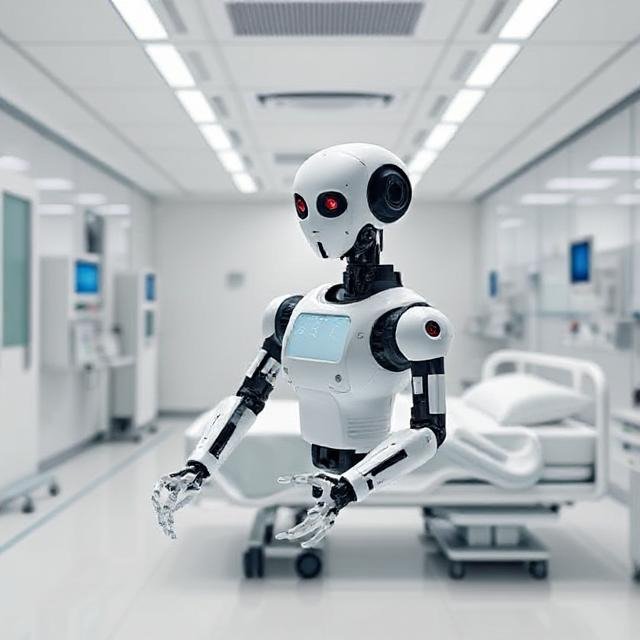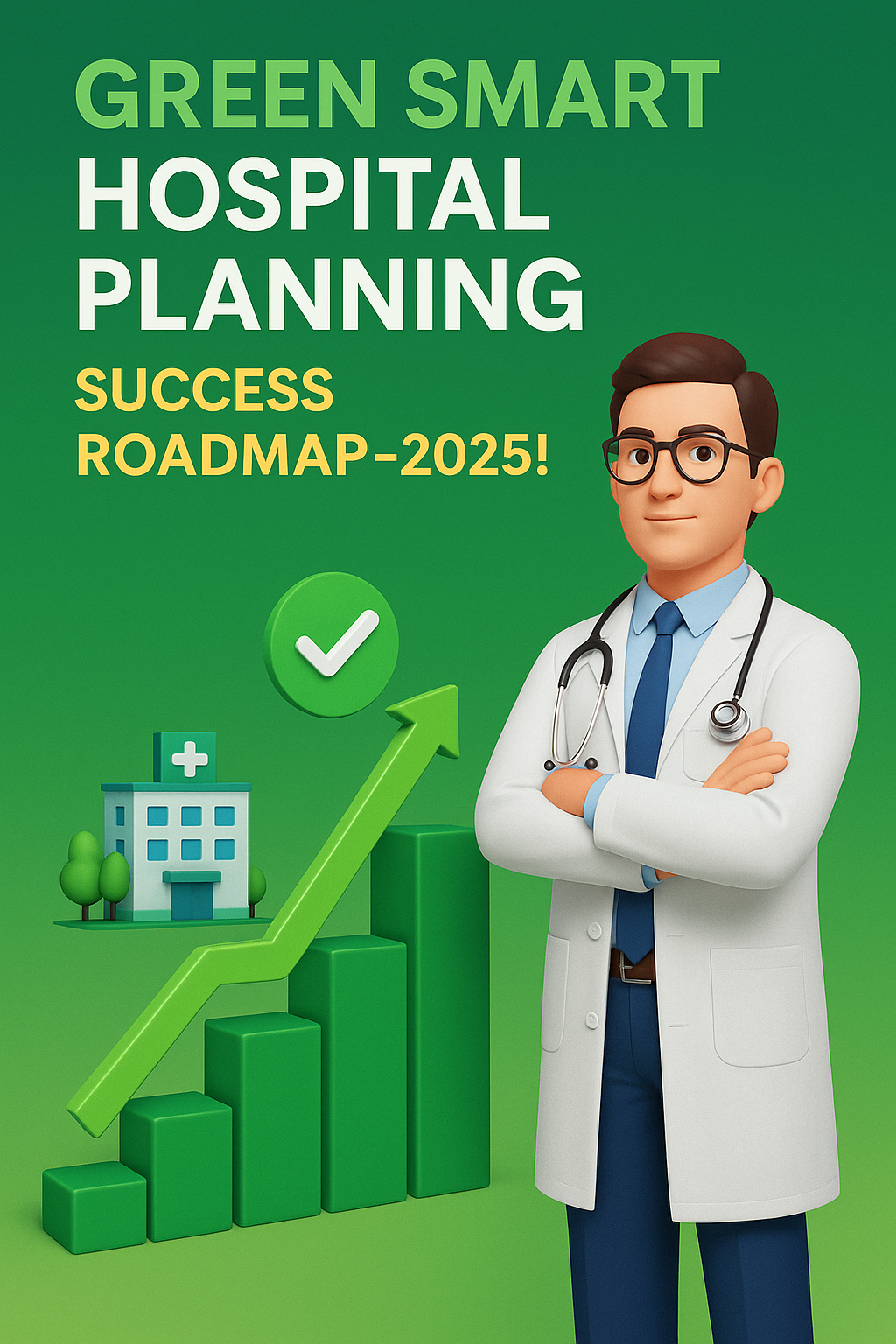
In a world increasingly defined by digital transformation, the healthcare industry is undergoing a fundamental shift. At the center of this evolution lies hospital automation — driven by Artificial Intelligence (AI) and robotics. Together, these technologies are reshaping every facet of healthcare delivery, from diagnostics to surgery, administration to logistics. The ultimate result? A new era of efficiency, precision, and patient-centered care, embodied by the SMART hospital.
A SMART hospital integrates intelligent systems and automation technologies to streamline processes, reduce human error, and enhance both clinical and operational outcomes. When thoughtfully combined with sustainable practices, it also evolves into a green hospital, meeting the growing need for environmentally responsible healthcare facilities. Strategic hospital planning is essential to ensure seamless integration of these innovations from the ground up.
This blog explores how AI and robotics are driving hospital automation, what it means for patients and providers, and how to align it with future-ready healthcare design principles.
What is Hospital Automation?
Hospital automation refers to the application of intelligent systems, machines, and software to perform tasks that traditionally require human intervention. These tasks can be clinical (like surgery or diagnostics), operational (like inventory tracking), or administrative (like scheduling or billing).
Automation technologies in modern hospitals fall into two broad categories:
-
AI-powered software systems: These leverage data, machine learning, and algorithms to support decision-making and automate cognitive tasks.
-
Robotic systems: These include physical machines used for surgeries, disinfection, delivery of supplies, and more.
When implemented strategically, these technologies make a hospital smarter — more efficient, responsive, and resilient.
Key Applications of AI in SMART Hospitals
1. Clinical Decision Support Systems (CDSS)
AI can analyze vast datasets, including lab results, imaging reports, and patient history, to provide clinical recommendations.
-
Example: IBM Watson Health assists in cancer treatment planning by reviewing case data against thousands of clinical studies.
-
Impact: Improves diagnostic accuracy, reduces time to treatment, and supports evidence-based care.
2. Predictive Analytics
AI models can predict patient deterioration, infection risks, or readmission probabilities.
-
Example: AI models in ICUs monitor vitals to predict septic shock hours before it happens.
-
Impact: Enables proactive intervention, reduces mortality rates, and shortens hospital stays.
3. AI-Powered Imaging
AI assists radiologists by detecting anomalies in X-rays, MRIs, and CT scans faster and with increasing accuracy.
-
Example: Deep learning algorithms flag early signs of lung cancer from CT scans.
-
Impact: Supports early detection, improves diagnostic consistency, and optimizes radiologist workloads.
4. Natural Language Processing (NLP)
AI interprets unstructured clinical notes, making it easier to extract meaningful insights from electronic health records (EHRs).
-
Example: NLP tools identify undocumented conditions in EHRs to aid in risk scoring.
-
Impact: Enhances documentation accuracy and revenue cycle management.
Robotics in Hospital Automation
While AI powers the brain of the smart hospital, robotics serves as the physical extension. Robotic systems are now essential across various hospital departments.
1. Robotic Surgery
Robotic-assisted surgeries offer precision, reduced invasiveness, and faster patient recovery.
-
Example: The da Vinci Surgical System enables minimally invasive procedures in urology, gynecology, and cardiac care.
-
Impact: Smaller incisions, less blood loss, shorter hospital stays, and higher surgical precision.
2. Pharmacy Automation Robots
Automated dispensing systems prepare, sort, and deliver medications with accuracy and speed.
-
Example: Omnicell and Swisslog robots manage drug inventory and fulfillment.
-
Impact: Reduces medication errors, improves workflow, and ensures compliance.
3. Logistics and Supply Robots
Autonomous Mobile Robots (AMRs) transport linens, medications, food, and waste across the hospital.
-
Example: TUG robots from Aethon navigate hallways to make deliveries without human intervention.
-
Impact: Saves staff time, improves safety, and enables around-the-clock operations.
4. Disinfection Robots
UV light-emitting robots sanitize operating rooms and patient wards, especially important during pandemic responses.
-
Example: Xenex LightStrike and UVD Robots are used worldwide for surface disinfection.
-
Impact: Reduces hospital-acquired infections (HAIs) and improves patient safety.
Automation in Hospital Administration
Beyond clinical areas, automation dramatically transforms hospital management and administrative efficiency.
1. Automated Scheduling
AI systems analyze availability, patient urgency, and staffing constraints to optimize appointment scheduling.
-
Impact: Reduces cancellations, maximizes utilization, and improves patient satisfaction.
2. Chatbots and Virtual Assistants
AI-powered bots handle patient queries, appointment reminders, and pre-consultation forms.
-
Impact: Reduces call center load, provides 24/7 support, and enhances patient engagement.
3. Billing and Claims Processing
Robotic Process Automation (RPA) automates repetitive billing tasks like data entry and insurance validation.
-
Impact: Speeds up revenue cycles, minimizes claim denials, and lowers administrative costs.
Green Hospitals: Sustainability Meets Automation
Hospital automation doesn’t only benefit healthcare quality — it also supports environmental sustainability. Automation enhances the green hospital concept by enabling better resource management.
1. Smart HVAC and Energy Systems
AI monitors occupancy and weather data to control heating, cooling, and lighting efficiently.
-
Impact: Reduces energy consumption by 20–30%, lowering the hospital’s carbon footprint.
2. Water and Waste Monitoring
IoT sensors and AI track water usage and segregate medical waste efficiently.
-
Impact: Minimizes resource wastage and ensures compliance with eco-friendly disposal protocols.
3. Paperless Operations
Digital records, AI transcription, and e-prescriptions reduce the need for paper-based workflows.
-
Impact: Contributes to deforestation reduction and lowers operational costs.
Incorporating automation into green design also improves hospital resilience to climate-related disruptions through energy efficiency and intelligent systems.
Hospital Planning for Automation: Key Considerations
To successfully implement automation, thoughtful hospital planning is crucial. Automation isn’t an add-on; it must be built into the hospital’s DNA.
1. Infrastructure Design
-
High-speed connectivity (5G, fiber optics)
-
IoT-enabled medical equipment
-
Smart floor plans to accommodate AMRs and delivery robots
2. Data Management and Cybersecurity
-
Scalable cloud storage and edge computing
-
Encryption, access control, and compliance with HIPAA/GDPR
3. Workforce Upskilling
-
Training programs for clinicians and staff to use AI/robotic systems
-
Reskilling administrative personnel for data-focused roles
4. Vendor Integration and Interoperability
-
Choose automation systems that integrate with your HIS, LIS, and EMRs
-
Ensure standards like HL7 and FHIR are supported
Tip for Planners:
Involve IT, clinical leadership, facility managers, and sustainability consultants in early design stages for holistic automation implementation.
Benefits of Hospital Automation
The impact of AI and robotics extends across the entire hospital ecosystem:
| Domain | Benefits |
|---|---|
| Clinical | Faster diagnosis, better outcomes, reduced errors |
| Operational | Streamlined workflows, lower costs, reduced turnaround times |
| Environmental | Energy and water savings, less waste, smarter resource utilization |
| Patient Experience | Shorter waits, virtual support, personalized care |
| Financial | Optimized billing, reduced labor costs, better asset management |
Challenges and How to Overcome Them
Despite its advantages, hospital automation comes with hurdles:
-
High Initial Costs
Solution: Use phased implementation, apply for government or CSR funding, and demonstrate ROI. -
Resistance to Change
Solution: Run awareness campaigns, pilot programs, and offer incentives for staff adoption. -
Data Privacy Risks
Solution: Prioritize cybersecurity audits, regular staff training, and multi-layered protections. -
Interoperability Issues
Solution: Work with vendors who offer open APIs and follow global health IT standards.
The Future: Toward Fully Autonomous SMART Hospitals
Looking ahead, automation will only deepen its role in hospital environments. We are already witnessing:
-
Digital twins of hospitals for simulating operations in real-time
-
Voice-controlled patient rooms for better accessibility
-
Emotionally intelligent robots to assist in mental health and geriatrics
-
Decentralized hospitals, where automation powers remote care hubs and mobile units
These advancements are not distant—they are actively shaping the roadmap for next-gen SMART hospitals.
Conclusion
Automation through AI and robotics is not merely a futuristic concept—it’s a transformative force actively reshaping how healthcare is delivered and experienced. By integrating intelligent technologies into every facet of hospital operations, healthcare institutions are evolving into SMART hospitals—responsive, data-driven ecosystems that prioritize efficiency, accuracy, and patient well-being.
From robotic surgical arms in operating rooms to AI-powered decision-making systems in emergency care, and from autonomous logistics robots navigating hospital corridors to NLP-driven chatbots supporting administrative staff—automation touches every corner of the modern hospital. These technologies don’t just make processes faster or cheaper—they make them smarter, safer, and more consistent. This level of precision and reliability is especially critical in high-stakes environments like critical care units, operating theatres, and neonatal ICUs.
But automation isn’t limited to the clinical side. When integrated into hospital planning from the ground up, it empowers architects, engineers, and administrators to reimagine space utilization, patient flow, resource allocation, and infrastructure needs. Whether it’s designing robotic pathways for deliveries, allocating areas for AI-controlled diagnostic labs, or integrating telemedicine pods into outpatient clinics, smart planning ensures that automation becomes a natural and seamless part of hospital operations.
Importantly, as environmental concerns become central to institutional accountability, hospital automation also plays a pivotal role in achieving green hospital objectives. Smart energy systems reduce power consumption. Automated waste management ensures safer disposal practices. Paperless workflows reduce environmental impact. By automating sustainability initiatives, hospitals not only reduce their carbon footprint but also set an example for other sectors in responsible innovation.
Moreover, a smart hospital is inherently scalable and adaptable. It is built to evolve—with software updates, new AI models, and modular robotics that adjust to emerging healthcare needs. This future-readiness ensures long-term cost-effectiveness and positions the hospital to embrace cutting-edge advancements like digital twins, immersive training simulations, and AI-enabled public health monitoring systems.
In essence, building a SMART hospital is not just a technological endeavor—it’s a strategic, ethical, and environmental commitment. It’s about embedding intelligence into every layer of the hospital—from infrastructure and operations to clinical care and patient experience. When aligned with green hospital practices and robust hospital planning, automation becomes more than a tool—it becomes a philosophy that defines the future of healthcare: sustainable, scalable, intelligent, and profoundly human-centered.


